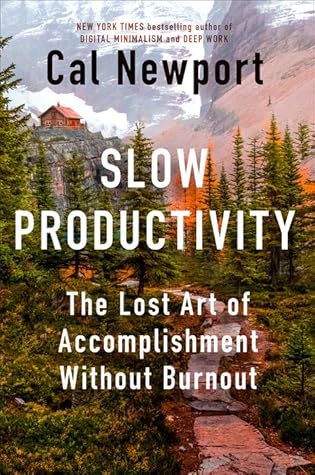More on this book
Community
Kindle Notes & Highlights
by
Cal Newport
Read between
January 17 - January 23, 2025
The relentless overload that’s wearing us down is generated by a belief that “good” work requires increasing busyness—faster responses to email and chats, more meetings, more tasks, more hours.
Do fewer things. 2. Work at a natural pace. 3. Obsess over quality.
this philosophy rejects busyness, seeing overload as an obstacle to producing results that matter, not a badge of pride. It also posits that professional efforts should unfold at a more varied and humane pace, with hard periods counterbalanced by relaxation at many different timescales, and that a focus on impressive quality, not performative activity, should underpin everything.
There’s a personal satisfaction in grimly pointing out the flaws in a system, but sustainable change, Petrini came to believe, requires providing people with an enjoyable and life-affirming alternative. Petrini didn’t simply write a sharply worded op-ed about the corruptive forces of McDonald’s, he instead promoted an appealing new relationship with food that would make fast food seem self-evidently vulgar.
“Those who suffer for others do more damage to humanity than those who enjoy themselves,”
In the modern office context, they tend to rely on stress as a default heuristic for moderation. If you turn down a Zoom meeting invitation, there’s a social-capital cost, as you’re causing some mild harm to a colleague and potentially signaling yourself to be uncooperative or a loafer. But, if you feel sufficiently stressed about your workload, this cost might become acceptable: you feel confident that you’re close to becoming unsustainably busy, and this provides psychological cover to skip the Zoom. You need to feel sufficient personal distress to justify the distress saying no might
...more
Consider, for example, a more palatable version of my New Yorker suggestion that I call the reverse task list. It works as follows: Create a public task list for each of the major categories of tasks you tackle in your job. You can use a shared document for this purpose. (If you’re feeling more advanced, a shared Trello board is perhaps even better.) When someone asks you to take on some small obligation, direct them to add it themselves to the relevant shared task list; writing it, for example, into the shared doc, or creating a new card for it on the shared Trello board. Critically, make it
...more
The key is to simulate a pull-based assignment system in such a way that the people you work with don’t even realize you’re trying something new.


